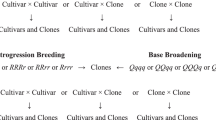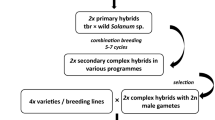Abstract
Three stages in the history of the utilization of wild potatoes are outlined, and it is suggested that we are now entering on a fourth stage, typified by a fuller international co-operation than has hitherto been possible.
The availability of useful genes is considered in the light of our knowledge of the crossability and evolutionary relationships of potato species. Breeding mechanisms in species at various levels of ploidy are shown to play an important part in speciation, and the significant role of asexual reproduction in potatoes is discussed.
The geographical localization of most genes carrying resistance to Phytophthora, viruses, Heterodera, Leptinotarsa and frost is discussed. Certain explanations to account for this localization are put forward.
Zusammenfassung
Bedeutung der Wildkartoffeln und Primitivformen für die Kartoffelzüchtung
In der Geschichte der Verwertung der Wildkartoffeln werden drei Stufen abgezeichnet und die Ansicht vertreten, daß wir eben in eine vierte eintreten, welch durch vollere internationale Zusammenarbeit als bisher möglich gewesen ist, charakterisiert wird.
Die Tatsache, daß wertvolle Gene zur Verfügung stehen, wird im Lichte unserer Kenntnisse der Kreuzbarkeit und der Entwicklungsbeziehungen von Kartoffelarten betrachtet.
Es wird aufgezeigt, daß Reproduktionsmechanismen in Arten auf verschiedenen Stufen der Ploidie eine wichtige Rolle in der Artzüchtung spielen, ferner wird die wichtige Rolle asexueller Reproduktion in Kartoffeln behandelt.
Die geographische Lokalisierung der meisten Genen, die gegen Phytophthora, Viren, Heterodera, Leptinotarsa und Frost resistent sind, ist hier behandelt. Erklärungen für diese Lokalisierung werden hier vorgeschlagen.
Zusammenfassung
In der Geschichte der Verwertung der Wildkartoffeln werden drei Stufen abgezeichnet und die Ansicht vertreten, daß wir eben in eine vierte eintreten, welche durch vollere internationale Zusammenarbeit als bisher möglich gewesen ist, charakterisiert wird.
Die Tatsache, daß wertvolle Gene zur Verfügung stehen, wird im Lichte unserer Kenntnisse der Kreuzbarkeit und der Entwicklungsbeziehungen von Kartoffelarten betrachtet.
Es wird aufgezeigt, daß Reproduktionsmechanismen in Arten auf verschiedenen Stufen der Ploidie eine wichtige Rolle in der Artzüchtung spielen, ferner wird die wichtige Rolle asexueller Reproduktion in Kartoffeln behandelt.
Die geographische Lokalisierung der meisten Genen, die gegen Phytophthora, Viren, Heterodera, Leptinotarsa und Frost resistent sind, ist hier behandelt. Erklärungen für diese Lokalisierung werden hier vorgeschlagen.
Samenvatting
Drie stadia in de geschiedenis van het gebruik van wilde aardappelsoorten en primitieve aardappelrassen worden genoemd. Omstreeks 100 jaar geleden waren nieuwe rassen nodig ter bestrijding van degeneratieziekten, terwijl omstreeks 1909 het wilde materiaal voor het kweken op ziekteresistentie ter hand werd genomen. Het 3e stadium begon in 1925 toen de eerste grote expeditie werd gehouden om materiaal te verzamelen voor een onderzoek naar de genetische variatie van de aardappelsoorten. Thans is men gekomen in het 4e stadium, nl. een nauwere internationale samenwerking dan tot nu toe mogelijk was.
Schrijver geeft een overzicht van de perspectieven voor het kweken op resistentie tegen Phytophthora, virusziekten, Heterodera, coloradokever en vorst. Het is gebleken dat bepaalde genen in bepaalde gebieden voorkomen (geographical localization).
Similar content being viewed by others
References
Bitter, G., Solana nova vel minus cognita. Rep. Spec. Nov. Reg. Veg. 10, 529–565; 11, 1–18, 202–237, 241–260, 349–394, 431–473, 481–491, 561–566; 12, 1–10, 49–90, 136–162, 433–467, 542–555 (1911–1913).
Bukasov, S. M., (The potato; in: The cultivated plants of Mexico, Guatemala and Colombia). Bull. Appl. Bot. Genet. Pl. Breed., Leningr., Suppl. 47 (1930): 191–226 (summary: 513–523).
Bukasov, S. M., (The potatoes of South America and their breeding possibilities.) Bull. Appl. Bot. Genet. Pl. Breed., Leningr., Suppl. 58 (1993) pp. 151 (translation by A. E. Trost pp. 34).
Cockerham, G., Potato breeding for virus resistance. Ann. Appl. Biol. 30 (1943): 105–108.
Cockerham, G., Ann. Rep. Scottish Plant Breeding Station. 1956: 11–16.
Ellenby, C., Resistance to the potato-root eelworm. Nature 162 (1948): 704.
Emme, H., (Studies on interspecific hybridization of tuber-bearing potatoes. Section Tuberarium Bitter., genes Solanum L.). Biol. Zhurnal 7 (1938): 1093–1104.
Gell, P. G. H., Wright, S. T. C. and Hawkes, J. G., Immunological methods in plant toxonomy. Nature 177 (1956): 573.
Gray, Asa., Wild potatoes in New Mexico and Western Texas. Amer. J. Sci. 22 (1856): 2, 284–285.
Hougas, R. W., Inter-regional potato introduction station, 1952. Seed and tuber list. Dept. of Genetics, Madison, Wisconsin. 1953. (Mimeographed).
Juzepczuk, S. W. and Bukasov, S. M., (A contribution to the question of the origin of the potato) Proc. U.S.S.R. Congr. Genet. Pl. Breed., 3 (1929): 593–611.
Klotzsch, J. F., Solanum utile Klotzsch, eine neue unserer Kartoffel ähnliche Art nebst ihren Verwandschaften. Allg. Gartenztg. 17 (1849): 313–316.
Lindley, J., Notes on the wild potato. J. Hort. Soc. 3 (1948): 65–72.
Niederhauser, J., Cervantes, J., and Servín, L., Late blight in Mexico and its implications. Phytopathology 44 (1954): 406–408.
Ochoa, C., Northern Peru, a possible new source of potatoes resistant to Phytophthora infestans. Amer. Patato J. 31 (1954): 371.
Propach, H., Cytogenetische Untersuchungen in der Gattung Solanum, Sect. Tuberarium V. Diploide Artbastarde. Z. indukt. Abstamm.-u. Vererb.-Lehre 78 (1940): 115–128.
Reddick, D., Blight resistant potatoes. Phytopathology 18 (1928): 483–502.
Rojas-Peña, E. de, El problema de las razas fisiológicas de Phytophthora infestans. Contribución a su estudio. Inf. téc. Min. Agric. Bogotá 1 (1953): 1, 1–49.
Ross, H. and Baerecke, M. L., Selection for resistance to mosaic virus diseases in wild species and hybrids of wild species of potatoes. Amer. Potato J. 27 (1950): 275–284.
Ross, H. and Baerecke, M. L., Über die Bedeutung der argentinischen Solanum-Arten simplici-folium, vernei, berthaultii, acaule, und einiger Formen von S. andigenum für die Züchtung krank-heitsresistenter Kartoffeln. Z.f. Pflanzenz. 30 (1951): 280–291.
Sabine, J., On the native country of the wild potato (with an account of its culture in the garden of the Horticultural Society). Trans. Hort. Soc. 5 (1824): 249–259.
Salaman, R. N., Inheritance of colour and other characters in the potato. J. Genet. 1 (1910): 7–46.
Schlechtendal, D. F. L. and Bouché, P. C., Über die wilde Kartoffel von Mexico. Verh. Ver. Beförd. Gartb. 9 (1833): 317.
Swaminathan, M. S., Overcoming cross-incompatibility among some Mexican diploid species of Solanum. Nature 176 (1955): 887–888.
Torka, M., Die Käferresistenz der Ser. Commersoniana von Solanum Sect. Tuberarium. Züchter 24 (1954): 138–139.
Verne, C., Sur les Solanum maglia et tuberosum et sur les résultats d'expériences de mutations gemmaires culturales enterprises sur ces espèces sauvages. C. R. Acad. Sci. 155 (1912): 505–509.
Wangenheim, K. H. F. von, Zur Ursache der Kreuzungsschwierigkeiten zwischen S. tuberosum L. und S. acaule Bitt. bzw. S. stoloniferum Schlechtd. et Bouché. Z. f. Pflanzenz. 34 (1955): 7–48.
Wight, W. F., Origin, introduction and primitive culture of the potato. Proc. 3rd Ann Meeting Potato Ass. America (in 1916) 3 (1917): 35–52.
Author information
Authors and Affiliations
Rights and permissions
About this article
Cite this article
Hawkes, J.G. Significance of wild species and primitive forms for potato breeding. Euphytica 7, 257–270 (1958). https://doi.org/10.1007/BF00025267
Received:
Issue Date:
DOI: https://doi.org/10.1007/BF00025267




